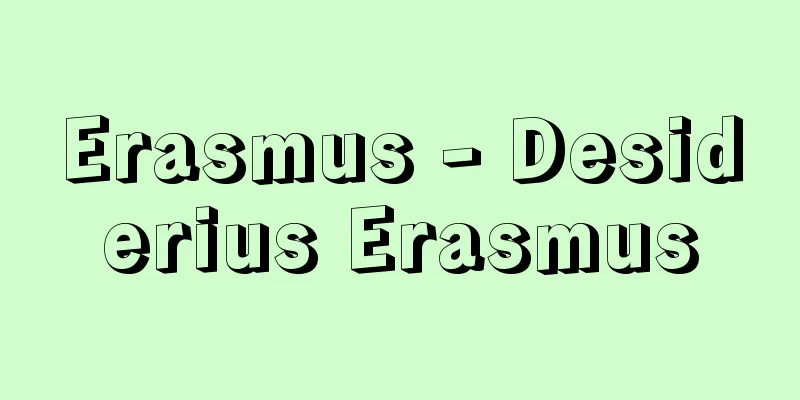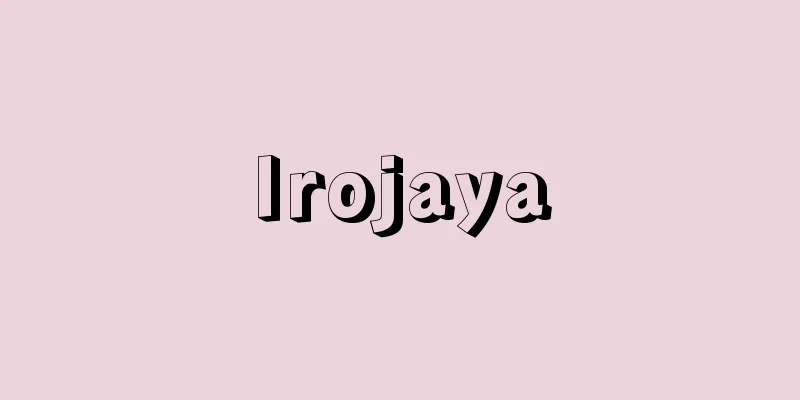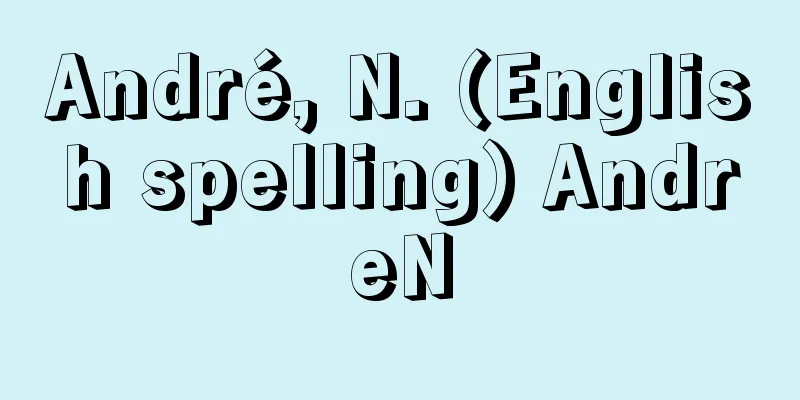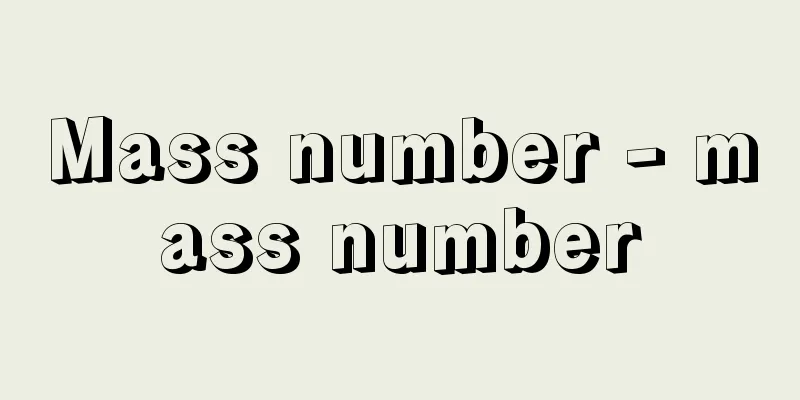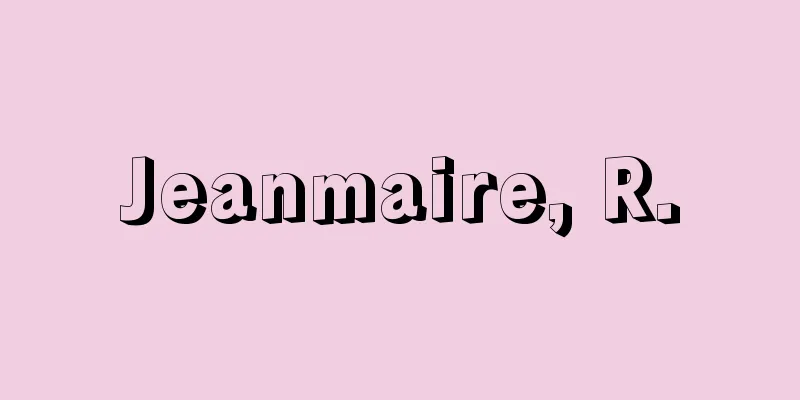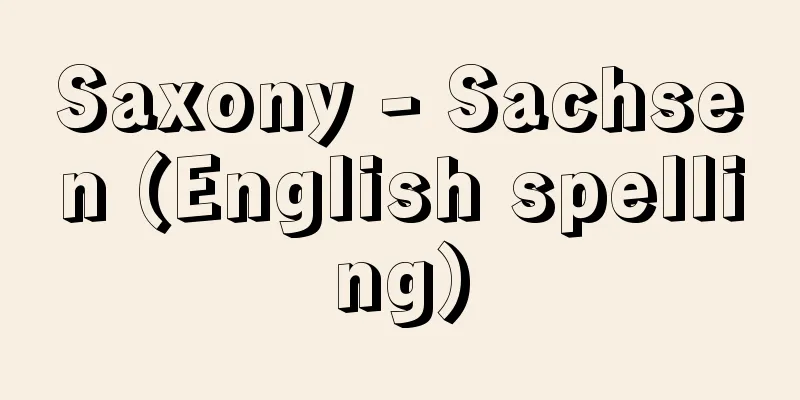Obi - Obi
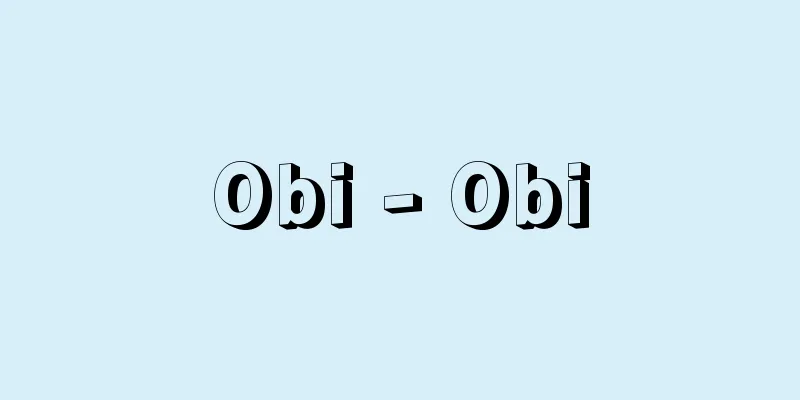
|
A type of clothing. In modern Japanese clothing, it is considered to be on the same level as a kimono, and is an indispensable part of wearing Japanese clothing. It prevents the left and right sides of the kimono from overlapping at the front, and adjusts the looseness of the width and the length of the body. It is both practical and decorative. In particular, women's obi are unique. There are types of obi for women, men, and children. Women's obi include maru obi, fukuro obi, Nagoya obi, fukuro Nagoya obi, haraawase obi, hitoe obi, and hanhaba obi, and are used for formal wear, formal wear, street wear, yukata, and everyday wear, respectively. Other types include hiyoku obi, light-weight obi (attached obi, improved obi), and o-zome obi. A special type is the kakeshita obi, which is tied under the uchikake. Men's obi include kaku obi, heko obi, and light-weight obi. [Yasu Fujimoto] kindsRound BeltThis obi is woven twice as wide as the obi itself, folded in half and sewn together. It is used for women's formal wear, formal attire and ceremonial attire. It is the heaviest and most luxurious obi, woven mainly with colorful auspicious patterns made with painted weft threads, and is called a "zentsushi" obi, with the patterns woven in one direction across the entire obi. Today it is mainly used for wedding attire, Japanese dance and formal gatherings. [Yasu Fujimoto] ObiIt is made using the bag weaving method and has both ends of the obi quilted. It was produced from around 1918 (Taisho 7) and became popular after the Second World War, and today it tends to be used in place of the round obi. Both ends of the obi width are looped, but recently some have been produced where the front and back are woven separately and both ends are sewn with a seam. There are full-length bag obi, but usually the lower part that wraps around the torso is woven plain in the ground color, and those with a pattern that covers eight-tenths of the obi length are called hachitsu, and those that cover six-tenths are called rokutsu. The woven pattern is only on the front side, while the back side is plain. Sometimes different patterns are woven on both sides, allowing both sides to be used differently. [Yasu Fujimoto] Nagoya obiThis obi is made by sewing the obi drum to the width of the obi and the waistband to half that width. This obi was invented during the economic depression of 1918 (Taisho 7) as an economical improvement of the belly band obi, changing the double drum of the drum knot to a single drum, and cutting the waistband, which was originally sewn to a width of 9 sun (34 cm), in half the width. There are six or eight patterns, and single patterns on the waistband and obi drum that are visible when the obi is fastened. In addition, there is also a type of obi that is not traditionally made, but is made to be the same width as the obi drum, which is called matsuba-style, and is easy to tie and versatile. This type has white habutae or white simpsons on the lining of the waistband. There are woven and dyed Nagoya obi. Woven obi have patterns woven into them similar to round obi and fukuro obi. Dyed obi are made from materials such as chintz, silk crepe, pongee, and habutae. There are also elaborate obi with embroidery. Dyed and embroidered obi are used for leisure and fashion. [Yasu Fujimoto] Fukuro Nagoya ObiIt is also called Kagari Nagoya and Hassun Nagoya. Nagoya obi is also called Kusun Nagoya, and is made by tailoring 9-sun obi fabric to 8 sun (30 cm), while Hassun Nagoya is woven to a finished 8-sun width, and these names were given to distinguish between the former and the latter. Fukuro Nagoya obi has a single waist, a hanging end where the ura-daiko is folded back, the front and ura-daiko pieces are joined together and the width is overstitched to make it look like one piece, and the hand end is folded in half about 25 cm wide, the hand tip is sewn, and the width is matched and overstitched. Fukuro Nagoya obi is available in high-quality woven obi, but it is worn on the same level as dyed Nagoya obi. [Yasu Fujimoto] Single BeltIt is a single-layer obi and is used exclusively as a summer obi. Kenjo Hakata, which was synonymous with summer single-layer obi, is still popular and worn today. Recently, this has also been woven with a weave for Fukuro Nagoya obi, and although it is a summer obi, it is no longer a pure single-layer obi in terms of its form. Obi for everyday wear come in normal width and medium width, thick woven in the style of tsumugi, and dyed, and many have stripes such as vertical stripes, horizontal stripes, and plaid. [Yasu Fujimoto] Half-width obiThe obi is a half-width obi (approximately 17 centimeters) in its entirety. There are those that are folded in half to make a round obi, and those that are woven in half width from the beginning. They are worn for everyday wear, at home, and are worn with yukata. Young people tie the obi in a bunko style, while older people tie it in a yanoji or kai no kuchi style. [Yasu Fujimoto] Lightweight beltIt is also called an attached obi or an improved obi. It is made by separating the waistband and the obi drum, wrapping the waistband around the torso and tying a string, and carrying the obi drum on the back with an obiage and obijime ties to complete the obi look. It has the advantages of being suitable for everyday wear at home, as a simplified mourning obi, and for travel and emergencies, but it also has the disadvantage that the fullness of the obi drum does not show the texture of the fabric. It has been improved many times in pursuit of a natural beauty in the tying of the obi, but in today's world, there is less demand for it. [Yasu Fujimoto] Square beltThis is a typical obi for men, worn for everyday wear or worn under formal hakama. Kakuobi used to be a round obi with a kuke pattern, but in recent times, fukuro-ori obi are mainly used. There are also single obi, which are about 9 centimeters wide and about 4 meters long. The fabrics used are Kenjo Hakata and donsu. [Yasu Fujimoto] waistbandA soft, coreless obi worn by men with casual wear. It is usually made of wide gold gauze, with tie-dyes on both ends or with full tie-dyes. Tsumugi is also light and easy to tie. Colors include black, gray, brown, and navy blue. [Yasu Fujimoto] Men's light beltIt is made of the same fabric as a heko obi, with a core around the waist and no core around the rest of the body. From the front, it looks like a square obi, but in the back, it is tied in two loops like a heko obi. It is used for everyday wear. [Yasu Fujimoto] Children's obiFor everyday wear, thin habutae or muslin fabric is used. Girls wear one solid color such as pink, red, or yellow, or one or two colors with a gradation, while boys wear blue colors such as light blue or navy blue. For a girl's 3rd birthday celebration, a simplified built-in obi is used, but for the 7th and 13th birthday celebrations, a child's round obi is worn with a shigoki or kae obi. [Yasu Fujimoto] historyIn the history of the development of clothing, the obi has been developed through its connection with humans since the earliest times. Before people started wearing clothes, they tied a string around their waist and used it as a sexual incantation to protect their genitals, to express their gender and marital status, for self-defense, and as a decoration for their waist. In the ancient Japanese records, the Kojiki, the obi is called "tarashi," meaning tied and hanging down. The obi worn by the human figures in the haniwa clay figurines from the Kofun period is tied in front or to the side. A similar figure can be seen in the murals of the Takamatsuzuka Tomb. The Asuka and Nara periods were times when Chinese culture was absorbed, and it was during the Heian period that it was absorbed and developed into a unique culture. During the development of clothing in Japan, the common people continued to wear the same clothes as in the previous period, holding the front of their clothes in place with a thin string-like obi. In the sokutai (traditional formal attire) and court lady's attire that developed in aristocratic society, the obi cannot be seen from the outside, but from the time when hoko and kun were worn, the front of the garment was held in place by leather obi, kanhata obi, soe obi, sekitai, and the waist of the mo, and today's obi were not used. With the rise of the samurai class, the hakama was simplified, and the osode outer garments of ladies' attire were removed, and the kosode, which had been worn undergarments, became the outer garment. As a result, the front of the kosode was held down with a narrow obi, and the obi began to show on the surface. During the Muromachi period, as the kosode developed, the kosode came to look like a pair of obi. Samurai women wore the obi over the inner garment underneath their uchikake, so it cannot be said that the obi had completely come onto the surface. For common people, the obi had completely come onto the surface, as can be seen in paintings such as "Rakuchu Rakugaizu Byobu" and "Taiko Yoshino Flower Banquet." From the Momoyama period to the early Edo period, there was no difference between men's and women's obi, and they wore the same thing. A single width of cloth was divided into eight equal parts, folded in half, and quilted, making it a narrow quilted obi. It was about 2 meters long, and the fabric was not a fixed obi fabric, but was made from fabrics such as outerwear or cut-to-size fabric. In addition to this narrow obi, when Toyotomi Hideyoshi set up his headquarters in Nagoya (Saga Prefecture) in Kyushu during the Bunroku Invasion (1592), he made a braided obi using the braiding technique called komauchi (karagumi), which is called Nagoya obi, and there are two types: flat braid (flat braid) and round braid (round braid). The Nagoya obi, with a 30cm tassel at the end, is wrapped several times and then tied to both ends and hung down, as can be seen in the "Hikone Screen," "Yuna," and "Weaving." [Yasu Fujimoto] For boysMen's obi were not originally woven to the width of an obi, but were made by cutting a piece of fabric, folding it in half, inserting a core, and quilting it. Fabrics used during the Genbun period (1736-41) were Tango amber and day and night weaving, and during the Kanpo and Enkyo periods (1741-48), Ueda stripes and white Kokura cotton obi were used, as well as striped satin, donsu, Hakata weaving, rinzu, shuchin, twill weaving, black tobi saya, and tsumugi stripes. During the Tenmei period (1781-89), it was fashionable to wear scarlet Hakata obi, or damask obi. This was called Harakiri obi. Until that time, black tobi sayao was commonly used, but as the years passed, sayao fell out of use and Hakata obi was worn by people of all ranks, rich and poor, and young and old alike. The real Hakata obi was Chikuzen Hakata, and was called Hon Hakata, and was expensive. Many people wore cheap imitation Hakata obi. Hakata obi has a white background with black stripes, and the central pattern is woven in the shape of a dokko (a single-pronged prong ... In addition to the single-pronged sash, there is also a striped stripe. A sash with the same color for the background and pattern is called a single-pronged sash. The length of a men's obi is 1 jo (hereafter, 1 shaku is approximately 38 centimeters. 1 jo is 10 shaku. 1 shaku is 10 sun), and the width is 1 sun 8 bu. This width is called the normal width and is called 8 bunyama. A sash that is 2 sun wider than the normal width is called a wide obi, and a narrow obi that is 1 sun 7 bu wider is called a thin obi. Genuine Hakata obi is made with Chinese thread or high-quality thread, so it does not stretch over time, but imitations have the disadvantage of stretching because they are not made with high-quality thread. Around the Tenpo era (1830-44), kobicha grounds were popular, but after that, navy blue grounds became popular. Also, the Funakoshi style, woven with checkered patterns, stripes, and solid colors, became popular from 1852 (Kaei 5). During the Ansei period (1854-1860), the Funakoshi style fell out of fashion and only the Kenjo Hakata style became popular. After that, designs with different patterns on the front and back became popular. However, both samurai and townspeople wore Honhakata for formal wear and on special occasions, and cotton Hakata obi for everyday wear. Honhakata came in navy blue, red, or light green, and Kenjo Hakata was used. From around 1852, the use of counterfeit goods increased, and the number of stores selling counterfeit goods increased. Cotton Kokura obi woven in Kokura, Buzen, came in plain or striped colors of leather, brown, or navy blue, and did not have a dokko woven in it. People of the middle class or lower used flat Sanada obi, a brown cotton obi with navy blue stripes. The width of this obi was about 6 centimeters. Before the Tenpo era, chiefs and gatekeepers employed by samurai families wore Rasha obi. Colors included white, light green, yellow, and brown, with yellow being the most commonly used. Yellow-striped Hattan woven from Hachijo Island was also used. In the first year of the Tenpo era, some hired servants and farmhands wore black hem and sashes. Men's obi are tied on the back at waist level. According to the Ruiju Kinsei Fuzokushi, the knot is used for the Rassa obi and the Heruto obi. The knot with a soft core and a dangling end is called Nekojarashi. Employees of samurai families used Kanda knot, craftsmen and rank-and-file samurai used Kai-no-kuchi knot, and samurai used Tate-musubi or Komageta-musubi knot. Tobi workers in Edo wore three-foot or six-foot obi. Three-foot obi are not tied on the back, but either left or right in front. During the Satsuma War in 1877 (Meiji 10), the white cotton obi worn by soldiers of Satsuma (Kagoshima Prefecture) around the waist was called Heko-obi. This spread among the general public and came to be used as an obi for everyday wear, made of white or colored fabrics such as crepe. Later, obi made of wide gold gauze with tie-dyed ends or all-tied obi came to be used. In contrast to heko obi, obi made with a core are called kaku obi, and are widely used under hakama for formal wear and for everyday use. Heko obi are used for everyday wear, but they are also used as obi for children using different fabrics. [Yasu Fujimoto] For women (Muromachi to Edo period)When kosode became outerwear and women's obi was first used as kosode obi, it was a narrow obi made by dividing a width of cloth into six equal parts, folding them in half, and placing waste paper in the core to make a quilted obi. During the Higashiyama culture period, even narrower obi made of eight parts were used. During the Azuchi-Momoyama period, there were no major changes after this. At that time, the same fabric as the outerwear was used for the obi. Warriors and wealthy upper classes used embroidery and foil, surihaku, and karaori, and used obi that was as gorgeous as the gorgeousness of the kosode. At that time, trade with Ming China had a great influence since the Muromachi period, and new and rare textiles were used. These were later called migurimono. Also, during the Muromachi period, Tsujigahana dyeing, which is a technique of shibori and drawing, was born, and it was at its peak from the Momoyama period to the early Edo period. Highly advanced dyeing and weaving techniques led to kosode becoming more luxurious, and naturally, obi sashes also developed into more ornate pieces. During the Bunroku era (1592-96), gold brocade was used, with plum, cherry and pine motifs sewn onto a black background, the obi was about 2 sun wide, and had washi paper as the core. In the Edo period, the width of the obi became wider, at 2.5 sun. Courtesans wore obi that were 5 sun wide. Fabrics used for the obi included karaori, thick board, silk crepe, and fabrics with embroidery and gold leaf. Until the Kan'ei era (1624-44), courtesans tucked the ends of their obi inside, but from the Meireki and Manji eras (1655-61), they began to tie the obi in front, and the courtesans and teahouse courtesans of Shimabara also began to wear their obi in front. The front obi gradually spread to townswomen in Kyoto and the countryside, but among wives of samurai families, it was never worn by women of any age. Around the Kanbun era (1661-73), there were three different ways to tie an obi: at the back, in the front, or on the side. At the back (at the back) was the way to tie before coming of age and became synonymous with young women, while at the front (at the front) and on the side came to represent married women. From the end of the Kanbun era, the width of the obi gradually widened, and by the Enpo era (1673-81), wide obi with three or two split damask linings came to be used exclusively. The length also doubled from 6 shaku 5 sun to 1 jo 2 or 3 shaku. Around the Enpo era, a style of tying obi, started by female Kabuki actor Uemura Kichiya, became popular. This style is called Kichiya musubi, and is a 3-inch wide obi with the ends tied in a single loop, like the drooping ears of a Chinese dog, and left to hang down. Obi makers were so familiar with this style that they even made long obi for Kichiya musubi. They even put lead in the ends of Kichiya musubi obi to add a creative touch to the way they hung down. Kabuki actors and geisha were the big influences on obi tying. It was female Kabuki actor Mizuki Tatsunosuke who made the Kichiya musubi obi hang longer to match the actor's height, and this style is called Mizuki musubi, and became popular after the Kanpo era (1741-44). In addition, the obi knot tied by Roko, a young Edo female actor, Segawa Kikunojo, led to the popularity of Roko tying. As obi became wider, changes began to appear in the way obi were made. Originally, obi were made by folding a piece of cloth in half and quilting it (similar to what we now call a round obi), but the first form of whale obi appeared around 1683 (Tenwa 3), and in 1687 (Jokyo 4) it came to be called hara-awase. From Jokyo to Genroku (1684-1704), obi widths widened, and when obi widths were narrow, they were tied around the waist, but around Hoei (1704-11) they came to be tied high on the chest. Around Enkyo (1744-48), obi widths reached 8 or 9 sun, and the earlier hara-awase obi came to be known as double-sided obi and became popular. This obi was called Kujira-obi (whale belt) around the Meiwa period (1764-1772), Hi-ya-obi (day and night belt) during the Tenmei period, and Hara-ai-obi (belt-wearing belt) during the Bunka period (1804-18); although the names are different, they are the same obi. This is a one-sided obi with different colors and fabrics on both sides. Originally, one side was made of black satin or velvet, and the other side was made of white satin, and it was said that it was named after the back and belly of a whale, or day and night, because the two different fabrics were sewn together. Generally, black and white were not the only colors used, and elaborate designs were also made, with one side being black and the other side being made of stripes, chintz, or ancient fabrics such as brocade and satin patched together. Obi made of different fabrics sewn together were for everyday use, and preferred fabrics were used, and they were popular among common people. From the middle of the Meiwa period to the Tenmei period, obi sashes came to take on a more important role than clothing, and many different tastes emerged. Black velvet obi sashes were popular at the time, followed by light green velvet obi sashes, along with dyed obi sashes with kinwa-zome and chrysanthemum-like patterns, eccentric Hachijo obi sashes, fur-permeable wool sashes, gold-free mohair sashes, and other fur-permeable wool sashes. In the Bunka and Bunsei periods (1804-1830), things became even more extravagant, and Edo geisha showed their Edo spirit by wearing fur-permeable ... However, towards the end of the Edo period, the trend for extravagance calmed down, and many kimonos had black satin on one side. [Yasu Fujimoto] ModernThe haraawase obi (belt-fitting sash) continued to be used from the Edo period through the Meiji, Taisho and early Showa periods. Black satin was used on one side, but colored satin such as white, cream, storeroom color, shrimp brown and purple were also used depending on age and preference. The fabric of the other side of the obi that went with this came in a variety of combinations such as shuchin, hakata, amber, kihachijo, habutae, habutae and crepe. Black satin was embroidered with gold, silver or colored threads, and in the Taisho and early Showa periods, satin with paintings made with oil paints appeared, which attracted people's attention and became popular. For summer obi, one side was made of satin, and the other side was made of a wide range of fabrics, including soft Karaori, itonishiki, ro tsuchin, yuzen habutae, shibori habutae, sarasa habutae, ro crepe, gauze, etc. The commonly used belly band obi was lighter than the round obi, had a wider range of uses, and could be worn in unique and diverse ways depending on how both the front and back were used. Due to the economic depression of 1918, the belly-wearing obi also became a target for improvement, and an obi designed by a woman was sold in a department store, causing a boom. This obi, called Nagoya obi, was significantly reduced in width to half the waist and the obi belt to a single drum. The length of the Maru obi and belly-wearing obi was over 4 meters, and it was tied in a double drum. After World War II, Nagoya obi was used for everyday wear and for special occasions, replacing the belly-wearing obi, and traditional obi were resewn into Nagoya obi, so that the belly-wearing obi naturally fell out of use. For obi with a wide width, the hiki-nuki style was used, but in 1813 (Bunkaku 10), when the reconstruction of the Taikobashi Bridge at Kameido Tenjin in Edo was completed, the taiko-musubi style started to be used. This was first done by a geisha from Tatsumi, Fukagawa, who tied it in honor of the Taikobashi Bridge. Later, this style was modified to create a wide variety of obi tying styles, and accessories such as obidome, obijime, obiage, and obimakura came to be used. In the Taisho period, the round obi with a dyed pattern became popular for formal kimono. Fabrics used were habutae, shiose, and rinzu. Also in the Taisho period, the fukuro-ori fukuro-obi was newly woven. The fukuro-obi came to the fore after the Second World War, and today it tends to be used instead of the maru-obi. The obi core inserted inside the obi was made of thick Mikawa cotton when the taiko-musubi style became popular, but today it is made of thin materials. For summer obi fabrics such as gauze and ro, a double core is used. The obi cores have also changed over the years. Non-woven synthetic fabric obi cores, which were developed after World War II, have the advantages of being light, elastic, and wrinkle-free, but because they do not match well with woven obi fabrics, they are only used in ready-made light-duty obi today. [Yasu Fujimoto] FolkloreThe obi that women normally wear today was originally a formal attire, but from around the Genroku period (1688-1704) in the Edo period, it gradually became popular among ordinary women for everyday wear. In the past, wide obi were only worn for ceremonial occasions, such as weddings, funerals, and special occasions such as New Year's Day and rice planting, and narrow obi, which could be called a single string, were worn in daily life. Even in picture scrolls, the obi of working women is depicted as a single string. There are various types of obi, not only in terms of fabric and tailoring but also in terms of how they are tied depending on the purpose, but this is probably a custom from the mid-Edo period onwards. Originally, obi was worn only on special occasions, and it is thought that in everyday life it was a thin string like the one mentioned above, but even when it became common to wear wide obi, it seems that the shape of the obi was used to distinguish between hare and ke (everyday life), and it also seems to have been used to express whether the woman was a married woman or a young girl, or even her age. Since the obi had an important meaning among clothing, it is also used with great significance in rites of passage, which are ceremonies for the stages of human growth. The obi celebration is a celebration for the growth of the fetus and for the mother. For children, there is the Shichigosan celebration, but in many regions, the 3rd year of the year is considered a celebration for girls, and they are given an obi by their mother's parents, called obi-musubi or obi-hajime. In some regions, it is called himotoki or obi-tame, and this is a celebration that the child has reached the age to wear a separate obi, excluding the attached string that was attached to the kimono until now. The obi tied in front is called mae-obi, and the style of mae-obi remains in festival dress, weddings, and funerals. In addition, the obi symbolizes the role of the gods, such as the mae-obi of the young child at festivals and the best obi owned by the wife of the festival's chief priest, which is worn by a selected girl over her shoulder to perform the role of a shinsengubu. Until recently, on Izu Oshima, a front obi was worn for formal attire, and on Enoshima in Kanagawa Prefecture, women who accompanied their new bride on greetings to their neighbors wore a front obi until the early Showa period. In Takayama City, Gifu Prefecture, the wife of the chief mourner wore a front obi at funerals. In Saga Prefecture, wives who lost their husbands wore a front obi for three days, called goke obi. We can see that different obi expressed the feelings of various people. [Hisako Maruyama] "Kitagawa Morisada, 'Ruishuu Kinsei Fuzokushi (Morissada's Manuscripts)' (1928, Buncho Shoin, reprinted 1963, Tokyodo Publishing)" ©Shogakukan "> Types of obi tying ©Shogakukan "> How to fold the obi Source: Shogakukan Encyclopedia Nipponica About Encyclopedia Nipponica Information | Legend |
|
衣服の一種。現在の和装では着物と同格とされ、和服を着装するうえに欠くことのできないものである。着物の左右の前の重なりを押さえ、身幅(みはば)の緩みと身丈(みたけ)を調節し整える。実用性と装飾性とを兼ね備えたものである。とくに女子の帯は特異な存在である。帯の種類には女子用、男子用、子供用とがある。女子の帯には丸帯、袋帯、名古屋帯、袋名古屋帯、腹合(はらあわせ)帯、単(ひとえ)帯、半幅帯があり、礼装、正装、街着、浴衣(ゆかた)、普段着用にそれぞれ用いられている。ほかに比翼帯、軽装帯(付け帯、改良帯)、お染め帯などがある。特殊なものには打掛(うちかけ)の下の掛下に締める掛下帯がある。男子の帯には角帯、兵児(へこ)帯、軽装帯がある。 [藤本やす] 種類丸帯帯幅の2倍の幅に織られ、これを二つに折って縫って仕立てた帯。女子の礼装、正装、盛装に用いられる。格が最上の重厚なもので、絵緯糸(えぬきいと)による多彩な吉祥(きっしょう)紋様を主体として豪華に織られ、全通しといい帯1本全体に一方向に紋様が織り出されている。今日は主として婚礼衣装、日本舞踊、正式な会合などに用いられる。 [藤本やす] 袋帯袋織によってつくられ、帯の丈の両端を絎(く)けて仕立てる。1918年(大正7)ごろから生産され第二次世界大戦後普及し、今日は丸帯にかわって用いられる傾向にある。帯幅の両端が輪になっているものであるが、最近表側と裏側とを別々に織り、幅の両端に縫い目をつけたものも生産されている。袋帯は全通しもあるが、普通は胴を巻く下回りは地色で無地に織り、帯丈の八分に紋様のあるものを八通(はちつう)、六分のものを六通(ろくつう)という。織り紋様は表側にのみあり、裏側は無地である。ときには両面に異なった紋様を織り出して、両面使い分けのできるものもある。 [藤本やす] 名古屋帯お太鼓を帯幅に、胴回りはその2分の1の幅に縫って仕立てた帯。1918年(大正7)経済不況の際、腹合帯を経済的に改良して考案された帯で、太鼓結びの二重太鼓を一重太鼓に、9寸幅(34センチメートル)をそのまま仕立てていた胴回りを半幅にしたものである。紋様づけは、六通か八通にしたものと、帯を締めたときに見える部分の胴回りとお太鼓に単独紋様を配置したものとがある。なお従来の仕立て方によらず、帯を締めやすくまた融通のきく松葉仕立てといわれる、お太鼓と胴回りの帯幅を同寸に仕立てたものも用いられている。これは胴回りの裏に白羽二重(はぶたえ)または白シンモスをつける。名古屋帯には織りの帯と染めの帯とがある。織りの帯は丸帯、袋帯に準じて紋様が織り出されている。染めの帯には更紗(さらさ)、塩瀬(しおせ)、紬(つむぎ)、羽二重などが用いられる。また刺しゅうを施した凝った帯もある。染めの帯、刺しゅうをした帯は、趣味に、またおしゃれ用として用いる。 [藤本やす] 袋名古屋帯かがり名古屋、八寸名古屋ともよんでいる。名古屋帯は九寸名古屋ともいい、帯幅9寸の帯地を8寸(30センチメートル)に仕立てたものであり、八寸名古屋は8寸幅のできあがりに織り上げた帯で、前者と後者を区別してつけられた呼び名である。袋名古屋帯は胴回りは単、お太鼓は垂端(たれはし)で裏太鼓を折り返し、表太鼓と裏太鼓とを2枚あわせ、幅をかがり縫いをして1枚のように仕立て、手の端は25センチメートルぐらい幅を二つに折って手先を縫い、幅をあわせてかがり縫いにする。袋名古屋帯には高級な織りの帯があるが、名古屋帯の染めの帯と同格に考えて締める。 [藤本やす] 単帯単の帯で、夏の帯としてもっぱら用いられる。夏の単帯の代名詞ともなっていた献上博多(はかた)は、いまなお人々に好まれて用いられている。最近これも袋名古屋帯用に織り出しがつけて織られ、夏帯ではあるが、形態的には純粋な単帯ではなくなったものもある。普段着用の帯には普通幅のもの、中幅のものなど、紬風で厚手に織られた織りのものと、染めのものとがあり、縦縞(たてじま)、横縞、格子縞など縞物が多い。 [藤本やす] 半幅帯全体が半幅(約17センチメートル)の帯。帯幅を二つ折りにして丸帯形式に仕立てたものと、初めから半幅に織られたものとがある。普段着用、家庭用、浴衣に締める。帯結びは若い人は文庫に、年輩の人は矢の字または貝の口に結ぶ。 [藤本やす] 軽装帯付け帯とも改良帯ともいう。胴回りとお太鼓とを分離してつくられたもので、胴回りの部分を胴に巻いて紐(ひも)を結び、形づくられたお太鼓を背に負い、帯揚、帯締をして帯付きの姿とする。家庭における普段着用として、また簡略化された喪服の帯、旅行や急場に対応できるなどの長所はあるが、お太鼓の膨らみに布味が発揮されていないなどの欠点もある。帯結びのよさに自然美を求め、改良が重ねられてきたが、今日の世情では需要が少なくなっている。 [藤本やす] 角帯男子の帯を代表するもので、普段着用、礼装の袴(はかま)下に幅広く締められている。角帯は丸帯形式の絎(くけ)帯であったが、最近は主として袋織のものが用いられている。また単帯もあり、幅9センチメートル前後、丈は4メートル前後である。布地は献上博多、緞子(どんす)などである。 [藤本やす] 兵児帯男子の普段着に締める柔らかい芯(しん)なしの帯である。主として金紗(きんしゃ)の広幅物を用い、帯の両端に絞りのあるもの、または総絞りのものが用いられる。紬も軽くて締めやすい。色は黒、ねずみ、茶、紺などがある。 [藤本やす] 男子の軽装帯兵児帯と同じ布地を用い、胴回りに芯を入れ、ほかの部分は芯なしにする。前からは角帯的にみえるが、後ろは兵児帯と同様に両輪奈(わな)に結ぶ。普段着用として用いる。 [藤本やす] 子供用の帯普段着用としては薄地の羽二重、またはモスリンの布地を用いる。女児はピンク、赤、黄など1色の無地、または1色、2色を用いてぼかしにしたもの、男児は浅葱(あさぎ)、紺などのブルー系のものが用いられる。女児の3歳の祝いには作り付けの簡略化された帯を用いたりするが、7歳、13歳の帯解(おびとき)の祝いには子供用丸帯を締め、これにしごき、または抱(かかえ)帯を締める。 [藤本やす] 歴史衣服の発達史上、帯はもっとも古くから人類とのかかわりあいをもって発達した。衣服を着用する以前は紐を腰に締めて結び、性的呪術(じゅじゅつ)として性器の保護、性別、婚否を表現し、護身用に、また腰の装飾のために用いた。日本の古い記録では、『古事記』に帯のことを「タラシ」といっており、結び垂らしているという意である。古墳時代の埴輪(はにわ)の人物像に締められている帯は、前または横で結んでいる。高松塚古墳の壁画に同様の姿がみられる。飛鳥(あすか)・奈良時代は中国文化を摂取吸収した時代で、それを受け、固有の文化へと消化し発展させたのは平安時代である。わが国の服飾発達途上において、庶民は前時代の服装形態をそのまま存続し、衣服の前合わせを細い紐状の帯を締めて押さえていた。貴族社会において発達した束帯(そくたい)、女房装束では、外観から帯を見ることはできないが、袍袴(ほうこ)、裙(くん)を着用したころから革帯(かわのおび)、綺帯(かんはたのおび)、紕帯(そえのおび)、石帯(せきたい)、裳(も)の腰などによって前合わせを押さえており、今日風の帯は使用していなかった。 武家の勃興(ぼっこう)とともに袴の簡略化が行われ、女房装束の大袖(おおそで)衣の表着を脱ぎ、下着に着用していた小袖(こそで)が表着になるのに伴って、小袖の前合わせを幅の狭い帯で押さえるようになり、帯が表面に現れてくる。室町時代には小袖の発達とともに、小袖、帯の姿となる。武家婦人は、打掛の下の間着の上に帯を締めているから、帯が完全に表面化したとはいえない。庶民においては、帯が完全に表面化しているようすを『洛中洛外図屏風(らくちゅうらくがいずびょうぶ)』『太閤(たいこう)吉野花宴図』などにみることができる。 桃山時代から江戸初期における庶民の帯は、男帯、女帯ともに差がなく、同様のものを締めていた。一幅の布を8等分にし、これを幅二つ折りにして絎けた八つ割帯で、幅の狭い絎帯であった。長さは約2メートルぐらいのもので、布地はとくに帯地という固定したものではなく、表着などの布地や切り売りの布地を利用していた。この細帯のほかに、豊臣(とよとみ)秀吉が文禄(ぶんろく)の役(1592)に本営を九州の名護屋(なごや)(佐賀県)に構えたときに、高麗打(こまうち)(韓組(からぐみ))という組紐技術によってつくられた組紐の帯を名護屋帯といい、平組み(平打ち)、丸組み(丸打ち)の2種がある。紐先に30センチメートルほどの房のついている名護屋帯を幾重にも巻き、のちに両輪奈に結び垂らしている姿を『彦根(ひこね)屏風』『湯女(ゆな)の図』『機織(はたおり)図』などにみることができる。 [藤本やす] 男子用男帯は初めは帯幅に織られておらず、織物の裂(きれ)を裁ってこれを幅二つ折りにして芯を入れ、絎けて製したものを締めていた。布地は元文(げんぶん)(1736~41)のころは丹後琥珀(たんごこはく)、昼夜織(ちゅうやおり)、寛保(かんぽう)・延享(えんきょう)(1741~48)のころは上田縞、小倉(こくら)木綿の白い帯を用い、ほかに縞繻子(しまじゅす)、緞子(どんす)、博多(はかた)織、綸子(りんず)、繻珍(しゅちん)、斜子織(ななこおり)、黒飛紗綾(くろとびさや)、紬縞などが用いられた。天明(てんめい)(1781~89)のころには緋(ひ)色の博多帯、緞子の帯を締めることが流行した。これを腹切り帯と称した。そのころまでは黒飛紗綾が一般に多く用いられていたが、年を経るにしたがって紗綾は用いなくなり、博多帯を貴賤(きせん)、貧富、老若の別なく用いた。博多帯は筑前(ちくぜん)博多が本物で、本博多といって高価であった。多くの人々は値段の安い模造品の博多帯を用いていた。博多帯は白地に黒の縞文(しまもん)があり、中央の文は仏具の独鈷(どっこ)形を織り出している。博多帯はこの独鈷の紋様を主として用い、江戸時代将軍家へ献上したことからこれを献上博多とよんだ。この文の1条のものを一本独鈷、2条のものを二本独鈷という。独鈷のほかにさらに縞筋がある。地色と文の色とが同一のものを共(とも)独鈷という。男帯の丈は1丈(以下、1尺は約38センチメートル。1丈は10尺。1尺は10寸)、幅は1寸8分。この幅が普通幅で八分山といった。普通幅より広い幅2寸のものを広幅、1寸7分幅の狭いものを細帯といった。本博多は唐糸や上質の糸を用いているから、年月がたっても伸びるようなことはないが、模造品は良質の糸でないために伸びる欠点がある。天保(てんぽう)(1830~44)ごろは媚茶(こびちゃ)地が流行したが、その後は紺地が流行した。また格子と縞と無地とで織り出した船越(ふなこし)形が1852年(嘉永5)から流行した。安政(あんせい)(1854~60)ごろは船越形が廃れ、献上博多だけが流行した。その後、表と裏とを異色異文に織ったものが流行した。 しかし武士や町人がともに、礼装および晴(はれ)の場合には本博多を用い、普段着用には綿の博多帯を用いた。本博多の地色は紺、赤、萌黄(もえぎ)などで、献上博多が用いられた。1852年ごろから模造品の使用者が多くなり、模造品を売る店が増加した。豊前(ぶぜん)小倉で織られた綿の小倉帯は革色、茶色、紺色の無地や縞のもので、独鈷は織られていない。中流以下の人々は、綿の茶地に紺の縞の平打ちの真田帯(さなだおび)を用いた。この帯の幅は約6センチメートルぐらいである。天保以前、武家に雇われた人の長や芝居木戸番は羅紗(らしゃ)帯を締めた。色は白、萌黄、黄、茶などで、なかでも黄色が多く用いられた。また八丈島で産する黄縞の八端(はったん)織なども用いられた。天保初年には雇夫や農夫のなかには黒のへると帯を用いたものがあった。 男帯は腰の位置で背に結ぶ。その結び方は『類聚(るいじゅう)近世風俗志』によれば、羅紗帯、へると帯は神田結びにする。帯の芯が柔らかく、結んだ端がだらりと下がる結びを猫じゃらしといった。武家の雇夫などは神田結び、工匠、平の武士は貝の口、武士は竪(たて)結びまたは駒下駄結びをもっぱら用いていた。江戸の鳶(とび)の者は三尺帯か六尺帯を締めた。三尺帯は背に結ばず、左の前か右の前のいずれかで結ぶ。1877年(明治10)の西南戦争で、薩摩(さつま)(鹿児島県)の兵隊たちが腰に締めた白い綿織物のしごきを兵児帯と称した。これが一般の人たちの間に広まり、普段着用の帯として用いられるようになり、布地は縮緬(ちりめん)などで、白または色物が用いられた。その後、広幅の金紗を用い、帯の両端に絞りをしたものや総絞りのものが用いられた。兵児帯に対し、芯を入れて仕立てた帯を角帯といい、礼装の袴下に、また平常用として広く用いられている。兵児帯は普段着用として用いているが、布地を異にして子供用の帯にも用いられている。 [藤本やす] 女子用(室町~江戸時代)女帯は、小袖が表着化し、小袖帯として用いられた当初、六つ割といって布の一幅を6等分し、これを幅二つに折り、芯に反古紙(ほごがみ)を入れて絎けた幅の狭い細い帯であった。東山文化の時代には、八つ割のさらに狭い帯が用いられた。安土(あづち)桃山時代には、この後を受けてそのまま大きな変化はなかった。このころは表着の布地と同様のものを帯にも用いていた。武家、富裕な上層階級の人々は繍箔(ぬいはく)、摺箔(すりはく)、唐織(からおり)などを用い、小袖の華やかさと同様に華やかな帯が用いられた。当時は室町時代より明(みん)との貿易による影響が大きく、織物も新しく珍しいものが用いられた。のちにいう渡り物である。また室町時代に絞りと描き絵による辻が花(つじがはな)染めが生まれ、桃山時代から江戸初期にかけて全盛をみた。高度な技術による染織は、小袖を豪華な方向へといざなった。これに伴って帯も、自然に華美なものへと発展することとなる。 文禄(ぶんろく)年間(1592~96)は金襴(きんらん)を用い、黒地に梅桜松を縫い付け、帯幅は2寸ほどで芯に和紙を用いた。江戸時代に入ると帯幅は2寸5分と広くなった。遊女の帯幅は5寸の幅広いものが用いられた。帯の布地は唐織、厚板(あついた)、繻珍(しゅちん)、繍箔や摺箔を施したものなどが用いられた。寛永(かんえい)(1624~44)ごろまでの遊女は帯の端を差し込んでいたが、明暦(めいれき)・万治(まんじ)(1655~61)のころから前で結ぶようになり、島原(しまばら)の傾城(けいせい)、茶屋遊女たちも前帯になった。前帯はしだいに京の町女、田舎(いなか)へと伝わったが、武家の奥方の間では老若いずれも前帯にすることはなかった。寛文(かんぶん)(1661~73)ごろには、帯の結び目の位置は後ろ結び、前結び、横結びの三様が行われ、後ろ結び(後ろ帯)は元服前の結び方で娘の代名詞となり、前結び(前帯)、横結びは既婚者を表すようになった。寛文の末ごろから漸次、帯の幅が広くなり、延宝(えんぽう)(1673~81)のころには緞子三つ割、二つ割の幅の広い帯がもっぱら用いられるようになった。長さも6尺5寸であったものが、1丈2、3尺と倍ほどに長くなった。 延宝のころ帯の結び方に歌舞伎(かぶき)芝居の女方(おんながた)上村吉弥(うえむらきちや)が始めた帯結びが流行した。これを吉弥結びといい、3寸幅の帯の端を唐犬(からいぬ)の耳が垂れているように、片輪奈に結んで垂れ下げた帯結びである。帯屋が心得て、吉弥結び用の丈長の帯をこしらえるほどであった。さらに吉弥結びの帯端に鉛を入れて、垂れ下がりに趣向を凝らした。帯結びは歌舞伎役者、芸者による影響が大きかった。吉弥結びの垂れ下がりを役者の身長にあわせて長く垂れ下げたのは歌舞伎役者の女方水木辰之介(たつのすけ)で、これを水木結びといい、寛保(かんぽう)(1741~44)以後に流行した。また江戸若女方(わかおんながた)瀬川菊之丞(きくのじょう)路考(ろこう)の結んだ帯結びにより、路考結びがはやった。 帯幅が広くなり、帯の製作の仕方に変化がみられるようになる。帯は本来、布幅を二つ折りにして絎けた絎帯(現在にいう丸帯形式のもの)であったが、1683年(天和3)ごろに鯨(くじら)帯の初めの形態が現れ、87年(貞享4)腹合せの名称でよばれるようになった。貞享(じょうきょう)から元禄(げんろく)(1684~1704)ごろに帯幅が広くなり、帯幅の狭いときは腰のあたりに帯を締めていたが、宝永(ほうえい)(1704~11)ごろは胸高に締めるようになる。延享(えんきょう)(1744~48)ごろは帯幅8、9寸の広さとなり、先の腹合帯は両面帯と称され流行した。この帯は明和(めいわ)(1764~72)ごろ鯨帯といい、天明は昼夜帯、文化(ぶんか)年間(1804~18)には腹合帯といい、名称は異なっているが同一形態の帯である。これは両面異なった色、布地を用いた片身替わりの帯である。初め片面に黒繻子やビロード、他の面に白地の繻子などを用い、2種の異なった布地を縫い合わせて仕立てたので鯨の背と腹、昼と夜に例えてよばれたものといわれる。一般には白と黒に限って用いられたのではなく、また片面に黒を用い、他の面には縞、更紗、または金襴や緞子などの古代裂を継ぎ合わせたものなどを用いるという凝ったものも行われた。異なった布を縫い合わせた帯は平常用のもので、好みの布が用いられ、庶民の間に好んで用いられた。 明和のなかばから天明のころには、帯が衣服以上に重要な位置を占めるようになり、さまざまな好みも多く現れた。そのころ流行したものは黒ビロード、続いて萌黄ビロードの帯であり、ほかに親和染や菊寿模様、変わり八丈、渡り物に風通毛織、金なしモール、更紗などである。文化・文政(1804~30)には一段と奢侈(しゃし)となり、江戸芸者は、渡り物の更紗、輪奈天(わなてん)、呉絽服連(ごろふくれん)、羅紗などを用いて、江戸の意気地をみせ、着捨ても惜しまないという社会世相を生んだ。これらの渡り物は非常に高価であり、たびたび奢侈禁止令、倹約令が出され、違反して入牢(じゅろう)、押収などの科(とが)を受ける者が出た。しかしこれらの禁令は、ないのと同じで、天保以後にもなお、おごった着服はさらに甚だしくなった。しかし江戸末期には奢侈の風も落ち着き、片側に黒繻子を用いたものが多くなった。 [藤本やす] 近代腹合(はらあわせ)帯は江戸時代より引き続き、明治、大正、昭和初期ごろまで用いられた。片側に黒繻子(くろじゅす)を用いていたが、白、クリーム、納戸色(なんどいろ)、えび茶、紫など、年齢および好みによる色物の繻子も用いられた。これにあわせる片側の帯の布地は繻珍(しゅちん)、博多、琥珀(こはく)、黄八丈、八端、羽二重(はぶたえ)、縮緬(ちりめん)など、いろいろな組合せがあった。黒繻子に金糸や銀糸、色糸を用いて刺しゅうを施して用いたり、大正・昭和初期には、繻子に油絵の具で絵画模様を描いたものが出て、人の目をひき、流行した。夏帯用として片側に繻子を用い、片側は柔らかい唐織、糸錦(いとにしき)、絽(ろ)繻珍、友禅羽二重、絞り羽二重、更紗羽二重、絽縮緬、紗(しゃ)など、広い範囲の布地が用いられた。広く一般に用いられた腹合帯は、丸帯よりも軽く、用途の範囲も広く、表裏の両面の用い方によってユニークで多様に装うことができた。 1918年の不景気の影響を受け、腹合帯も改良の対象となり、一女性の考案による帯がデパートで売り出されブームをよんだ。これは胴回りを半幅に、お太鼓も一重太鼓へと大幅に倹約された帯で、名古屋帯という。丸帯、腹合帯の帯丈は4メートル余もあり、二重太鼓に結んだ。名古屋帯は普段着用、晴れ着用にと、第二次世界大戦後は腹合帯にかわって用いられ、また従来の帯を名古屋帯へ仕立て替えたりして、腹合帯は自然に用いられなくなった。 帯幅の広い帯結びは引き抜きを用いていたが、1813年(文化10)江戸・亀戸(かめいど)天神の太鼓橋の再建完成を機に、太鼓結びが行われるようになった。これは、深川の辰巳(たつみ)芸者が太鼓橋にちなんで結んだのが最初である。その後、この結び方を変形して多種多様の帯結びもでき、帯留、帯締、帯揚、帯枕(おびまくら)などの小物が用いられるようになった。大正において、訪問着用に染め模様の丸帯が流行した。布地には羽二重、塩瀬、綸子が用いられた。また大正には、袋織の袋帯が新しく織り出された。袋帯は第二次世界大戦後クローズアップされ、現在は丸帯にかわって用いられる傾向にある。帯の中に入れる帯芯は、太鼓結びの流行に伴って、厚地の三河木綿を用いていたが、今日では薄手のものを使用している。夏の紗、絽などの帯地には二枚芯を用いる。帯芯も年代とともに変化している。第二次大戦後にできた合成繊維の不織布の帯芯は、軽くて弾力性があり、しわにならないなどの長所があるが、織物の帯地としっくりいかないなどから、今日では既製の軽装帯などに用いられている程度である。 [藤本やす] 民俗現在、普通に婦人が締めている帯は、もともと礼装のときのものであったが、江戸の元禄(げんろく)(1688~1704)のころからしだいに一般女性の間に平常用として普及してきた。昔は幅広い帯を結ぶのは、冠婚葬祭の儀礼と、正月、田植などのハレの日に限っていて、日常生活では一筋の紐(ひも)というべき幅の狭いものであったという。絵巻物の絵でも、働いている女性の帯は一筋の紐に描かれている。帯には、用途によって生地(きじ)、仕立て方だけでなく、結び方でもさまざまな種類が知られているが、これもおそらく江戸中期以後の風俗であろう。もともと帯を締めるのはハレの日で、平素は前に述べたような細紐のようなものであったと思われるが、幅のある帯を締めることが普通になっても、形によってハレとケ(日常)とを区別しようとしていたこと、さらには、それによって人妻か娘か、または年齢までも表現しようとしていたようである。 帯は服装のうちでもたいせつな意味をもっていたので、通過儀礼と名づけられている、人の成長段階の儀礼においても、それぞれ重要な意義をもって使われている。帯祝いは胎児の成長を祈るとともに母親の身祝いでもある。子供の側としては七五三の祝いがあるが、3歳は女児の祝いと考えている地方が多く、帯結び、帯はじめといって母親の実家から帯を贈られる。地方によっては紐解(ひもとき)、帯解などといい、これは、いままでの着物についていた付け紐を除いて、別に帯を締める年齢に達したという、お祝いであった。帯を前で締めるのを前帯というが、前帯の風は祭礼の礼装や婚礼、葬送のときに残っている。また、祭りの際のお稚児(ちご)さんの前帯、祭りの頭人(とうにん)の妻のもっている最上の帯を、選ばれた少女が肩にかけて神饌供奉(しんせんぐぶ)の役を勤めるなど、帯が神役を象徴するものとされた。伊豆大島では近年まで礼装の際は前帯であったし、神奈川県江の島でも昭和初年まで、新嫁を連れて近所へ挨拶(あいさつ)回りする婦人は前帯を締めた。葬式のときに喪主の妻が前帯にしたのは岐阜県高山市。佐賀県では後家(ごけ)帯といって夫を亡くした妻は3日間前帯を締めたという。帯によって、さまざまな人の思いを表していたことがわかる。 [丸山久子] 『喜田川守貞著『類聚近世風俗志(守貞漫稿)』(1928・文潮書院、復刻1963・東京堂出版)』 ©Shogakukan"> 帯の結び方の種類 ©Shogakukan"> 帯の畳み方 出典 小学館 日本大百科全書(ニッポニカ)日本大百科全書(ニッポニカ)について 情報 | 凡例 |
Recommend
Ibacus incisus (English spelling)
… [Takeda Masatomo]. … *Some of the terminology t...
Chodowiecki, D.
…In England, the first exhibition was held in 176...
Ordo Fratrum B.Mariae Virginis de Monte Carmelo
…A Catholic contemplative order. Also known as th...
Breeding Farm - Breeding Farm
...There are some dairy businesses in urban areas...
Urakawa [town] - Urakawa
A town in Urakawa County in south-central Hokkaido...
Inome Cave - Inome Cave
…Also called a cave. An underground space formed ...
The Seoul Press
…Published by the Keijo Ilbo. In opposition to Ko...
Radiation dose - hoshasenryo
Radiation dose refers to the amount related to the...
Sofu Teshigahara
Ikebana artist. First head of the Sogetsu school. ...
Sakanoue no Karitamarō
728-786 A warrior from the Nara period. Born in t...
Liu Fu-tong (English spelling)
[raw]? [Died] 1363 One of the warlords in the late...
Heterotropa crassa (English spelling) Heterotropa crassa
… [Mitsuru Hotta]... *Some of the terminology tha...
Tsukidate [town] - Tsukidate
An old town in Kurihara County, northern Miyagi Pr...
Megaselia spiracularis
...This is called the coffin fly, Conicera tibial...
Negative resistance - Fusei Teiko (English spelling) negative resistance
This refers to the case where mechanical or electr...
